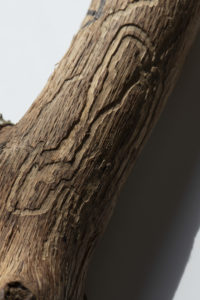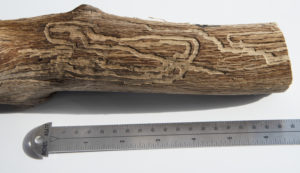

Red oak borers leave distinctive trails (galleries) in the wood of the tree.
Photo Credit: E.P., DeMotte, Indiana
Q. In 22 years I’ve had more than a dozen oaks die because of a grub or larvae. Symptoms: First the leaves die and turn brown at the top of the tree. It slowly spreads down the tree until all the leaves are brown and have fallen off. Then the bark begins to peel away from the trunk, and then it falls off pieces at a time. You can see where it cuts off the water supply to the tree. It spreads from tree to tree, usually the closest to the one affected. It may be nine months total time before the tree dies. I’m sure this is spreading in the forest behind my house. – E.P., DeMotte, Indiana
A. Our Purdue Entomology Specialist was able to identify the culprit as a longhorned beetle called red oak borer. The gallery pattern showing right angles and dead ends are distinctive for this species of borer. As with other kinds of borers, stressed trees are more likely to be attacked. By the time you’re seeing symptoms, it is too late to help that tree.
The best strategy is to protect trees not yet affected by alleviating stress as much as possible, such as irrigating during prolonged dry weather. Woodpeckers may provide some biological control, but they damage the bark and wood during their foraging. Remove dead and damaged trees to help reduce overwintering beetle population.